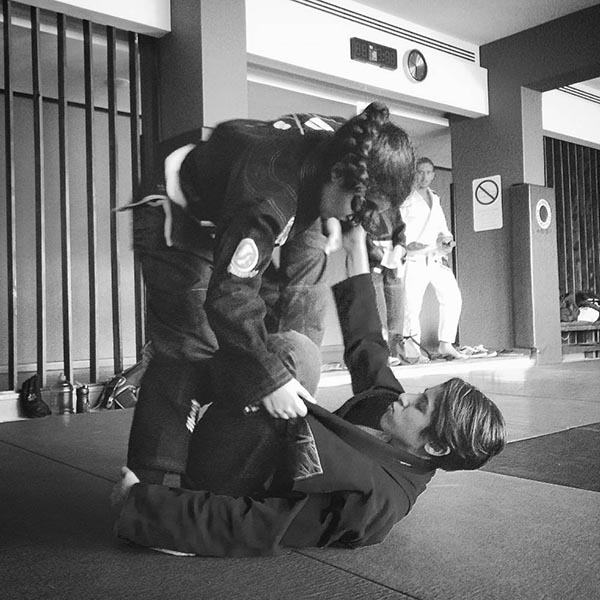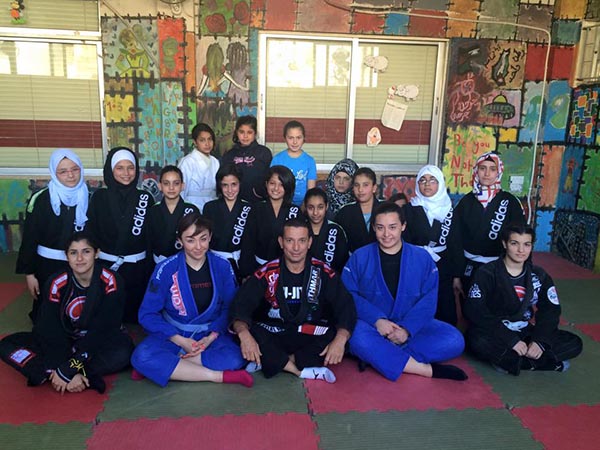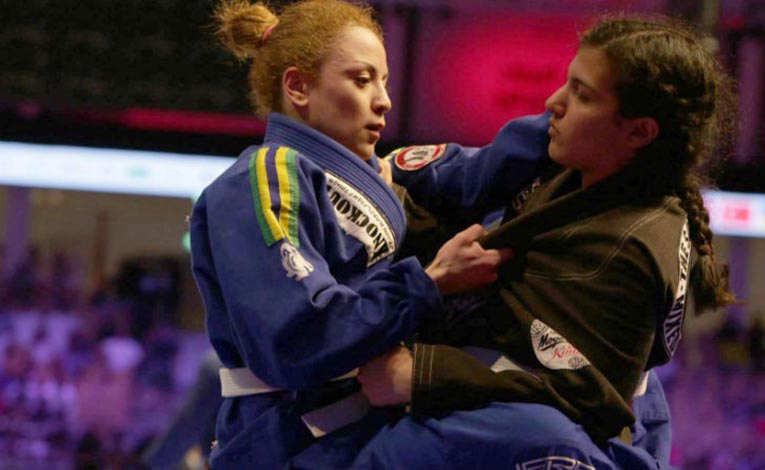In the Middle East, a female jiu-jitsu fighter works to eliminate bias against women in combat sports.
No historian can say for certain whether the Amazons existed. Some say they lived in a matriarchal society, where little girls were raised as warriors and men took care of the babies. Some say they were a figment of the Athenian imagination, a way to frighten the men into cooperating during times of “political stress.”
In 1861, Johann Jakob Bachofen’s Das Mutterrecht, or Mother Right, presented a theoretical ancient world: polyamorous, communistic and with a religion recognizing a matriarchal rather than a patriarchal line. Some interpreted this to mean that the dark ages of humanity ended with the enlightened advent of patriarchal rule and monogamous marriage. More recently, feminists use the theory to hypothesize about a utopia ruled by women.
To be fair, however, the idea of harmonious women living in villages and engaged in peaceful goddess worship is less threatening than the idea of an Amazon who fights “like a man.” A vicious, skilled, aggressive woman scandalized and titillated the Greeks. Only when the tale expanded to include a macho Heracles defeating and subjugating Hippolyta, the Amazonian queen, could the men relax—the feral woman was under control.
In the modern world, the entrance of women into traditionally male combat sports, including boxing, cage fighting/mixed martial arts (MMA) and Brazilian jiu-jitsu (BJJ), stir the same sense of horrified fascination. Rhonda Rousey is perhaps the most recent example of this: A hugely successful, hugely talented, disciplined fighter still paradoxically criticized both for her “masculine” body and traditional good looks.
Rousey is a mixed martial artist, combining techniques from other disciplines such as boxing, judo, muay thai and Brazilian jiu-jitsu. BJJ, in particular, appears very much the man’s sport, with on-the-ground grappling and twists designed to “submit” the opponent, or get them to tap out. The gripping of clothing, the claustrophobia and the odd intimacy of BJJ make it seem like an odd sport for a woman to take up, especially considering that often both genders “roll,” or compete, with each other.
Defeating Stereotypes

Enter Farah al-Zahrani, a 21-year-old Saudi university student living in Jordan and now a female BJJ competitor. Zahrani is the first Saudi woman to compete in BJJ and, perhaps more importantly, one of the first Saudi women to compete in sports, full stop. Although the 2012 Olympics in London saw two entries by Saudi Arabia—16-year-old Wojdan Shaherkani in judo and 19-year-old Sarah Attar in track—both of them lost by significant margins to opponents and brought the lack of facilities and training for Saudi women into the limelight.
Zahrani has the same frustration while visiting relatives in Saudi Arabia. “There are no places to train in Saudi,” she says in an international school accent. “I’ve been here in Saudi for three weeks and I’m going crazy.”
When asked how she began BJJ, she says it was an accident. “I’ve always been involved in sports. I did taekwondo, swimming, gymnastics and started BJJ a year and a half ago. One of my friends was doing a Kickfit class at an MMA place, and it was a combination between a cardio workout and kickboxing. So I did Kickfit to stay fit, and there was Kickfit on one side and BJJ on the other side. I would always watch them and I couldn’t understand what they were doing. I was astonished by how graceful and smooth their movements were but, at the same time, it was weird, too intimate. I was like, I’m never going over there!”
Shaking out her mane of hair, she says ruefully, “I asked, ‘Are there any girls training?’”
Zahrani placed fourth in the World BJJ Championships in Abu Dhabi in her weight and in the open division, where all weight classes compete together. Although she has only trained for a year and a half, she is earnest in her love of jiu-jitsu and her desire to compete.
“One of the concepts of BJJ is the smaller and weaker person can submit the bigger and tougher guy. Size doesn’t really matter—technique matters, how you use the technique to submit your opponent. I’m about 55 kilos and I’m one of the smallest girls. The fact that I can use BJJ to submit larger girls and guys is mind blowing to me,” she says.
Brazilian jiu-jitsu traces its lineage from judo and Japanese jiu-jitsu. The word jiu-jitsu comes from the Japanese “ju jutsu” or “gentle/supple/yielding art.” This is perhaps the essence of jiu-jitsu, which to the untrained eye looks like two people squirming and rolling around with each other. BJJ’s grappling and rolling involves being on top of, beneath, across and behind the opponent—in positions that those who prefer traditional gender roles might find scandalous. Except, of course, during a roll the point is to defeat the other person.
Although the formal combat techniques in a BJJ roll cannot translate directly from gym mat to street fights, BJJ does purposefully work to give the advantage to the smaller, weaker opponent and is considered by some to be a good basis for self-defense. For women, this could mean a moment’s advantage and the ability to get away when facing physical street harassment or assault.
Of course, this still doesn’t mean that walking into a gym full of men rolling around on the floor is any less intimidating.
“I didn’t really understand anything at first or get anything,” says Zahrani when asked about her first days doing BJJ. “They said OK, there’s this move called the arm bar and I couldn’t connect the moves and technique with like, how you do it in a real life match. I thought I would just try. I liked it.”
“I train with the guys in class,” she continues, “but some of the guys prefer not to train with girls. They might be religious or they just don’t like training with girls. You get to choose sometimes—you do what you’re comfortable with.”
When asked about her coach and his openness toward women in a male-dominated sport, she says, “My coach is Jordanian, but he was born and raised in Brazil. His name is Samy al-Jamal. He’s a fourth degree black belt and he’s very supportive of what we do. He’s very, very supportive of the girls. Our school has a lot of girls, that’s what makes it special—we’re eleven girls now. None of the schools have that amount of girls.”
Faced With Harassment
Zahrani then comments on whether living in Jordan is difficult, or if she has faced harassment from others because of her competition in the sports, especially sans the hijab worn by both Shaherkani and Attar.
“In Jordan, people are more open-minded than in the Gulf,” she responds, sighing. “We have female boxers, and soccer players and basketball players, so sports are something common here. But BJJ is different because they think it’s violent, and because they think it’s all about breaking other people’s hands and legs or something like that. But in general they’re more open-minded than people in KSA—they think I just punch people and get hurt.”
“My relatives in Saudi, they are supportive, but they don’t know exactly what I’m doing and they don’t really ask. They knew I was competing in Abu Dhabi, so they were like, we saw you on TV, but they have nothing to say about this. Some of the Saudi people are very negative. I [received] very negative criticism when my pictures were online on social media because I was the first Saudi to ever compete in BJJ and people said I was a sinner. Like, ‘She’s going to hell.’”
She pauses for a moment and continues: “On Twitter and Instagram, there’s this page called ‘First Saudi’ and they put pictures up of the first Saudi to do anything, so they had my picture up, and I was reading through the comments—some of them were hurtful. ‘No one wishes her well’ or, like, ‘She has no father. Where is her father?’”
“I was questioning myself: I thought maybe I’m doing something wrong, like I wasn’t raised ‘right.’ But there’s nothing wrong with what I do. There’s this image of Saudi girls that they should be wearing a niqab or hijab, but I don’t wear that when I’m in Jordan. When my pictures were on social media, there was nothing showing—my body was covered in BJJ clothes but I didn’t have anything on my hair. So they were like, she’s a sinner.”
“My father is very protective of me from people, especially on social media, and he would be annoyed if he saw such comments. I have to keep in mind how to dress and how to post pictures, like I shouldn’t put stuff up that is too weird. I can’t just tweet whatever is on my mind. I have to be careful what I put out there.”
Notably, both Shaherkani and Attar were heavily criticized for participating in the Olympics, with some even calling the teenage Shaherkani a “prostitute for the Olympics.” While this is a distinct reaction from Saudi Arabia, where women only recently began competing, even in the United States, with Title IX sports legislation for women, doing something “like a girl” means doing it weakly. Our global obsession with women being weaker and, if they demonstrate strength, somehow “masculine” recalls an ancient attitude that the modern world has still not shaken.

Zahrani, luckily, has a good head on her shoulders and growing support from a small niche of women, including Muslim women, taking up fighting and combat sports. The Tumblr Muslim Female Fighters posts daily photos of women in combat sports from Turkey to Malaysia and Canada. As for Zahrani, herself, she has bigger dreams for her future.
“Some of my friends don’t really understand; they find it intimidating or ‘not feminine.’ They say, ‘Do you think you’re going to be a world champion? You’re wasting your time.’”
“I keep doing it because I like it. I keep doing it for myself; it affects me mentally and physically in a very tremendous way. I’m usually not a very patient person, but after doing BJJ I became the most patient person ever. I have a very short temper, but when I started doing BJJ I got this negative energy out of me because of punching the bags and training and fighting my teammates. You can’t just train twice a day and then just quit, you know? You have to do the whole thing.”
“In BJJ, I want to be a world champion, to be honest. I want to compete every opportunity there is, every tournament. I just want to go and compete,” she says, running her hands through long, wavy hair. “I want to train all the time. When I get my black belt or my brown belt, I want to open up a school in Saudi for girls to train in martial arts. I’m kind of working on that.”
When asked about her thoughts beyond competition, she shrugs, smiling, and says, “I think more Saudi girls should be involved in sports because they should be able to be healthier, not only their bodies, but their minds should be healthier—they should be able to stand up for themselves. Sports should be in every school in Saudi. Not sports as in training and competing, but just going to the gym and having a workout or keeping healthier, it affects a lot of things. Not only your body, but your mind as well. It plays a big, big role in people’s lives in general.”
“I’m also looking for a sponsor,” she says, grinning again. “I want to keep competing but, you know, BJJ competitions are kind of expensive and I’m still in school. But I want to try; I want to keep trying to compete. I’d love for my for my country to support me, my country’s recognitions and support is more important to me than whatever medals I might get at tournaments. I know I can offer a lot to the female Saudi community.”
Fight Like An Amazon
Zahrani is, perhaps, one of a new generation of young women across the world learning to blend the traditionally “masculine” characteristics of competitiveness and ambition with what it means to be female. “I’m not a tomboy,” she says, “There’s not just one kind of being feminine!”
It is a shame that, even while we have created the spaces for these young women to be celebrated and pushed, we still see in the backlash and comments a fear hearkening all the way back to times when women were considered to be property.
It is a fear of the woman who cannot be controlled, who cannot be subjugated and who cannot be pressed into docile, obedient silence. Women who can punch a man and control the situation if a man attempts to, in BJJ terms, submit her. Fear of the woman who is too feral, too wild and too outside the limits of what we consider to be appropriate, weak feminine behavior. Behaving “like a girl” is perhaps our way of making sure that women remain in the comfortable box, defeated by muscled, macho heroes, appropriately scantily clad and helpless.
Yet if it is up to the Zahranis and Rouseys of the world, we will have to begin rethinking our gendered definitions and our fear of women who might fight not like a man, but like an Amazon.
Courtesy of: Fair Observer
Photo Credit: Elena Koshevaya
